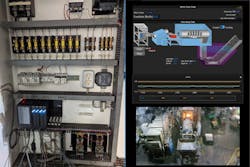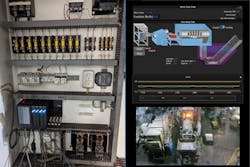Figure 1: Metal parts heat-treating specialist American Metal Processing in Warren, Mich., updated controls and HMIs on its seven rotary furnace lines by developing a homegrown solution based on Opto 22's groov EPIC control system and I/O modules. It also used groov View embedded visualization server software to duplicate functions of the previous PC-based feeder HMI, integrate control elements to create a unified and logically arranged operator interface, add IP camera feeds to display feeder hopper levels, and make all the screens available on mobile devices. Source: AMP and Opto22
Beyond gaining data processing power to improve capabilities, some edge devices and software are merging formerly separate functions into hybrid controls, human-machine interfaces (HMIs) and other tools that are more efficient and cost-effective. Of course, these combinations can also erase former boundaries, or perhaps show they were illusions to begin with.
For instance, American Metal Processing (AMP) in Warren, Mich., specializes in rotary heat treating to strengthen and protect small metal parts with deep-case carburizing, carbonitriding and neutral, quench-and-temper hardening. It runs seven rotary furnace lines 24/7 and uses precise control to yield tighter physical tolerances and greater product uniformity.
AMP's furnaces had progressed from the precisely calibrated weights and scales they used in the 1970s to DOS-based controls in 1993 and programmable logic controllers (PLCs) in 2000, but after 20 years, these controls were regularly failing and limited to controlling the feed system. Also, the feeder's HMI was reaching end-of-life, and most other system components weren't integrated or automated beyond direct motor control. The company also needed automated interlocking, alarm notifications and HMI improvements to reduce operator errors and double entries. Finally, AMP wanted to modernize its controls to establish seamless process data logging and integration that could communicate with their existing material- and lot-tracking database.
"We were on borrowed time. The system was primitive by today's standards," says Grant Pinkos, president of AMP. "We wanted it to be more than a control system. We wanted intelligence and a backend that would be on our network and fully connected to our SQL database."
This article is part of a series covering edge computing. Read the rest of the series now.
The five main sections on the furnace lines are:
- Feeder with two-stage, vibratory metering and PLC-controlled feed rate specified from a PC-based HMI.
- Pre-wash using high-temperature spray and a fixed-speed, rotating barrel driven by a 1/2-hp, three-phase AC motor and speed reducer.
- Rotating, cylindrical retort furnace with two-position direction selector to vary dwell times, internal temperature maintained by Eurotherm 3205 PIC controllers, and rotation rate controlled by an Allen-Bradley PowerFlex 525 variable frequency drive (VFD) and a 1 hp motor through a 900:1 gear reducer. Drive output frequency is set on an integrated control panel.
- 7,000-gallon quench tank with water or oil that's continuously circulated by a fixed-speed pump driven by a 30-hp, 230 V, three-phase AC motor.
- Conveyor belt that's driven by a 2.5-hp, 230 V, three-phase AC motor, and removes treated parts from the quench tank.
To upgrade the controls for the furnace lines, as well as computerized weighing and burner management systems, AMP decided to pursue a homegrown solution because it would allow them to control development, retain ownership and source-code access, and be able to modify or expand the system without added labor costs. It identified Opto 22 as a possible supplier while examining a feeder I/O panel from 1993, and this suggested a potential foundation for its new controls.
"The Opto 22 I/O modules were some of the few parts still working," adds Pinkos. "We got a quote for a groov EPIC system, and I could see the pieces coming together. When I realized I could do data logging with groov EPIC, that checked another box, and once we found a way for our lot-tracking database to use REpresentational state transfer (REST) calls to extract data from groov EPIC, we had a complete solution. groov EPIC made it possible to create our homegrown system.”
Built on groov EPIC's quad-core ARM processor (GRV-EPIC-PR1), AMP's initial system incorporated I/O modules for serial communications, V/mA analog output, DC output and thermocouple/mV analog input. The feeder scale was monitored via a serial input, and both vibratory stages were controlled through 0-10 VDC outputs. The retort furnace's controls were integrated with the overall control program by using one serial input channel to measure rotational speed of the furnace, one analog output for setpoint control to the VFD, one discrete DC output to the VFD to control the direction of rotation, and four temperature readings of the furnace body and internal atmosphere. The conveyor was integrated by using an additional serial input to monitor the belt speed.
Finally, AMP’s groov EPIC was connected to the company's network, completing a basic design and foundation for continuing enhancements. These included lot tracking and data logging, additional safety measures, and alarms such as overfeed and underfeed monitoring with process logic to interlock the upstream feeder and pre-wash systems. A Node-RED IoT platform embedded in groov EPIC was also used to query AMP's database for alarm occurrences, create matching string representations, perform text-to-speech (TTS) processing, and create audio announcements directing operators to alarm locations.
AMP also used groov EPIC’s embedded visualization server to create external HMI and mobile displays. It duplicated functions of the previous PC-based feeder HMI and integrated control elements to create a unified and logically arranged operator interface, including IP camera feeds to display feeder hopper levels.
“The new system is easy to understand and even easier to visualize, which builds confidence with existing customers and helps attract new ones,” adds Pinkos.
About the Author

Leaders relevant to this article:



